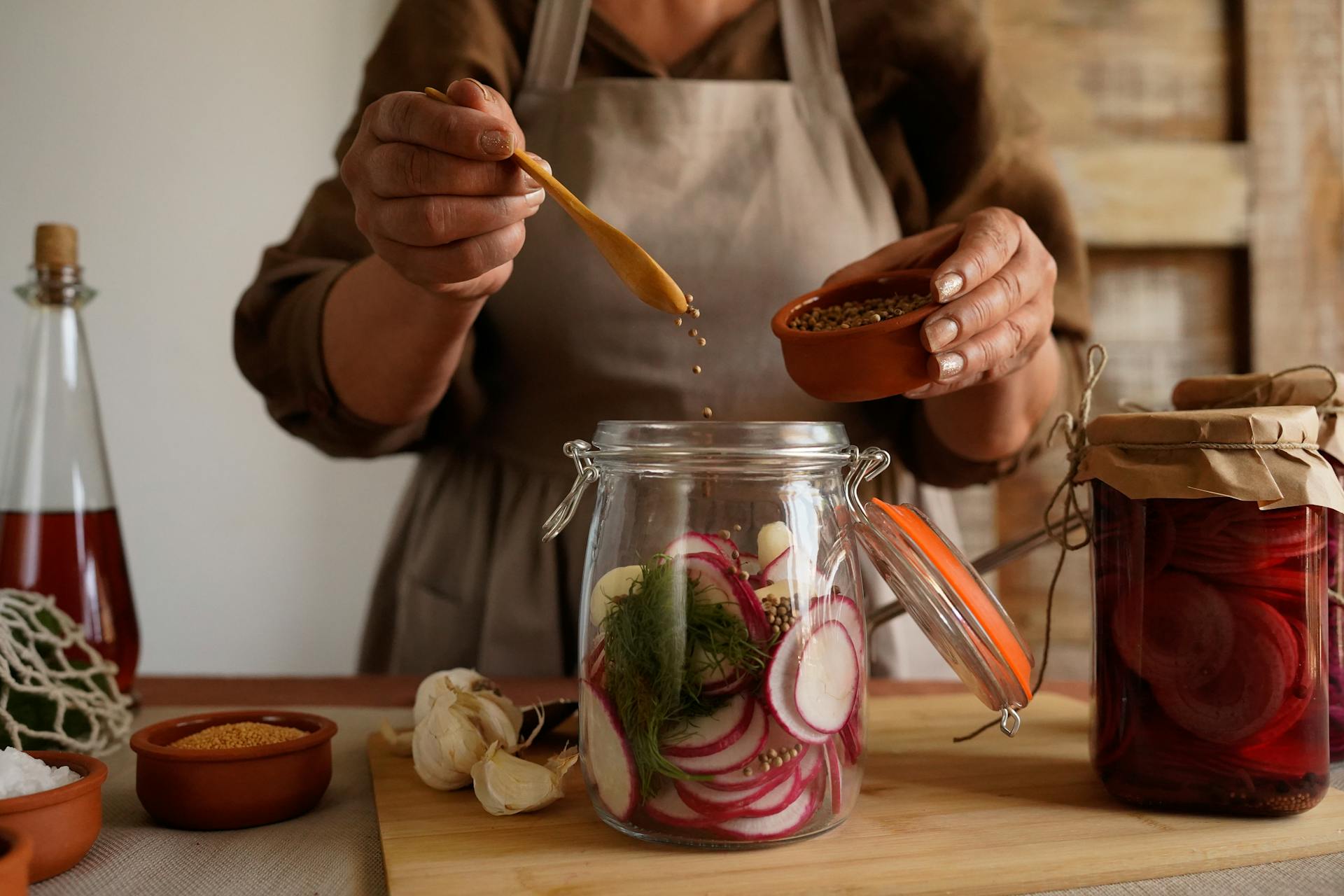
Storing homemade dog treats for long-term requires careful consideration to maintain freshness and safety. It's best to store them in airtight containers to prevent moisture and pests from getting in.
A good rule of thumb is to use containers that are specifically designed for storing food, such as glass or plastic containers with tight-fitting lids. These types of containers can be found at most kitchen supply stores.
To keep treats fresh, it's essential to store them in a cool, dry place, away from direct sunlight and heat sources. This will help prevent the growth of bacteria and mold.
A temperature range of 50°F to 70°F is ideal for storing homemade dog treats, as it prevents the growth of bacteria and mold.
See what others are reading: Dog Treats Containers
Storage and Preservation
Homemade dog treats can be stored in an airtight container for up to two weeks or in the refrigerator for up to 1 month. They can also be stored in the freezer for several months, but it's essential to wrap them tightly in foil or use an airtight container to prevent freezer burn.
For longer-term storage, vacuum-sealed bags are a great option, keeping treats fresh for up to a year. You can also freeze uncooked dog treat dough and defrost it later to make more treats.
To ensure your treats stay fresh, it's crucial to cool them completely before storing. Allow them to cool for at least three hours, preferably on a wire cooling rack, to prevent condensation and spoilage.
Can Be Frozen?
You can freeze homemade dog treats for longer term storage. In fact, most homemade dog treats are good for several months when stored in the freezer.
Make sure to pop them into an airtight container or wrap them tightly in foil to prevent freezer burn. This way, you can enjoy your creations for months to come.
Frozen treats can be given to your dog while still frozen, but thinner ones are often enjoyed frozen as they're super crunchy. However, frozen treats don't taste as good as thawed ones do!
Consider reading: Homemade Frozen Dog Treats for Sensitive Stomachs
Using a vacuum sealer is also a great way to extend the storage life of dog treats. Popping vacuum sealed bags filled with treats into your freezer can keep them fresh for up to a year.
You can also freeze uncooked dog treat dough and defrost it to make more treats later on. This is a great way to save yourself prep work next time.
Cool Completely Before
Cooling your treats completely before storing is crucial for their texture and shelf life. This means allowing them to cool on a wire rack for at least three hours after baking.
Even a little residual warmth can cause condensation, making your treats damp and spoiling their crunchiness. This can happen quickly, so it's essential to wait the recommended time.
For large or thick treats, cooling time may need to be longer. It's not a one-size-fits-all approach, so be sure to check the specific recipe for guidance.
Remember, a wire rack allows air to circulate freely around your treats, which helps them cool more efficiently. This can make a big difference in how long they stay fresh.
Making Homemade Dog Treats
Making homemade dog treats is a fun and rewarding experience for you and your furry friend. You can use ingredients like peanut butter, banana, and oats to create tasty and healthy treats.
To ensure your homemade dog treats stay fresh, it's essential to store them properly. Homemade dog treats can last for up to two weeks when stored in an airtight container in the refrigerator.
Make Homemade
Homemade dog treats can be made in a variety of textures, but if you want them to last longer, it's best to make them dry and crunchy.
Dry, baked treats have the longest shelf life, up to one week in the larder and up to two weeks in the refrigerator.
The crisper and crunchier your baked treats are, the longer they'll stay fresh.
If your treats contain meat, fish, or cheese, they should always be stored in the refrigerator or freezer, no matter how crunchy they are.
Here's an interesting read: How to Dry Chicken for Dog Treats
They'll be good for around five days in the refrigerator.
Soft, baked treats store relatively well, generally staying fresh for up to five days in the refrigerator.
These kinds of treats should always be kept in the refrigerator or freezer.
If you notice any signs that your treats have gone off, it's best to err on the side of caution and discard them.
Keep your homemade dog treats in an airtight container to maintain freshness.
Ingredients
Fruits and vegetables can make dog treats softer, even when they're completely cool, which affects their storage and freshness.
These treats typically have a shorter lifespan and should be stored in an airtight container in the refrigerator, where they'll last for one to two weeks maximum.
Treats made with gluten-free flour, especially if they contain fruit or vegetables, tend to stay soft and don't store as well as those using whole-grain flour.
Gluten-free treats should be kept in an airtight container in the refrigerator for up to a week and inspected regularly to ensure they're not going soggy or showing signs of spoilage.
Recipes that include meat, fish, or a meat-based broth or bouillon should be stored in the refrigerator as soon as they're completely cool, using an airtight container, and will last for around five days.
If you've used butter or margarine in a dog treat recipe, those treats are likely to spoil a little faster and should be refrigerated.
For more insights, see: Is Deli Meat Bad for Dogs
Storage Options and Containers
For homemade dog treats, you'll want to store them in a way that keeps them fresh for as long as possible. A good rule of thumb is to store them in an airtight container, which can be a glass, ceramic, or stainless steel jar, or a truly airtight, BPA-free plastic container that's refrigerator safe.
If you're storing treats on the countertop, a glass, ceramic, or stainless steel jar is a great option, as long as it seals air-tight. And if you're buying online, be sure to check the size of the container before you hand over your money!
Take a look at this: How Long Are Homemade Dog Treats Good for
For refrigerator storage, a BPA-free plastic container is a good choice. The Brilliance by Rubbermaid containers are a great option, as they're versatile, functional, and safe for the refrigerator and freezer.
You can also store treats in the freezer, using a sturdy freezer bag or a freezer-safe container. Be sure to label the container with the description and date, so you can easily keep track of what's inside.
Worth a look: Dog Safe Treats
Dehydrated
Dehydrated dog treats are a great option for storing treats long-term. They have the longest shelf life of all, and can stay fresh for several weeks in the larder.
Increasing the crunch-factor of your treats by drying them out a bit more at the end of their recommended baking time can make them even more suitable for dehydrating. This can be done by turning off the oven, opening the door a crack, and leaving the treats inside while the oven cools.
Dehydrated treats can be stored in an airtight container in the larder for several weeks. They can also be stored in the freezer for up to three months for even longer freshness.
You might like: Dehydrated Chicken Liver Dog Treats
Gummy

Gummy treats can stay fresh in an airtight container in the refrigerator for up to five days.
If you want to keep them longer, freezing is a good option. They will stay fresh for several months in the freezer.
Storage Options
You can store dog treats in an airtight container for up to two weeks, or in the refrigerator for up to a month.
For countertop storage, a glass, ceramic, or stainless steel jar works well, as long as it seals air-tight.
Choose a container that matches your decor, and consider the size and style of the container before buying online.
For refrigerator storage, a truly airtight, BPA-free plastic container is a good choice.
For freezer storage, you can use a sturdy freezer bag or choose any freezer-safe containers you like.
Dry, crunchy treats store well and can usually be kept in an airtight container in the larder for a week.
Discover more: Dog Store Names
In the refrigerator, dry treats can be stored for up to two weeks.
Frozen dog treats last a long time in your freezer and are a great option for hot summer days.
Here's a summary of storage options for different types of dog treats:
Remember to always check the treat's texture and smell before offering it to your dog, and to label and date your containers for easy identification.
Mini Paws
Mini Paws are a great option for storing small treats or snacks. You can use them in the oven, refrigerator, freezer, and dishwasher, making them super convenient.
The silicone material is what makes them so versatile - wet ingredients won't stick to the mold.
Frequently Asked Questions
How do you keep homemade dog treats crispy?
To keep homemade dog treats crispy, let them cool on the baking sheet and sit out in the open overnight to dry further. This helps maintain their crunchiness for a longer period.
How to package homemade dog treats?
To package homemade dog treats, use Resealable Cello Bags for individual treats like cookies, brownies, or truffles. You can also consider decorative tins for a more elegant presentation.
How do you keep dog biscuits fresh?
Store dog biscuits in air-tight containers to keep them fresh. Make sure the container is dry, clean, and has a tight-fitting lid.
Do dog biscuits need to be refrigerated?
Yes, homemade dog biscuits typically need to be refrigerated due to their lack of preservatives, which can cause them to spoil quickly at room temperature. Proper storage helps maintain freshness and food safety.
Sources
- https://www.momontimeout.com/homemade-dog-treats/
- https://kitchenconfidante.com/simple-sundays-homemade-dog-biscuits-treats-recipe
- https://www.akc.org/expert-advice/lifestyle/homemade-dog-treats-recipes-tips/
- https://www.wiggleworthy.com/store-homemade-dog-treats.html
- http://www.dogtreatkitchen.com/how-do-i-extend-the-shelf-life-of-homemade-dog-treats.html
Featured Images: pexels.com


